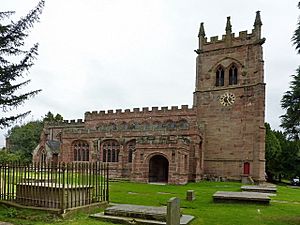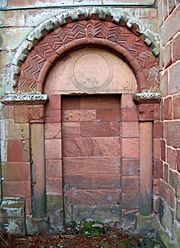St Bertoline's Church, Barthomley facts for kids
Quick facts for kids St Bertoline's Church, Barthomley |
|
|---|---|

St Bertoline's Church, Barthomley, from the south
|
|
| Lua error in Module:Location_map at line 420: attempt to index field 'wikibase' (a nil value). | |
| OS grid reference | SJ 767 524 |
| Location | Barthomley, Cheshire |
| Country | England |
| Denomination | Anglican |
| Website | St Bertoline, Barthomley |
| History | |
| Status | Parish church |
| Dedication | Saint Bertoline |
| Events | Massacre in the Civil War (1643) |
| Architecture | |
| Functional status | Active |
| Heritage designation | Grade I |
| Designated | 12 January 1967 |
| Architect(s) | Austin and Paley (chancel) |
| Architectural type | Church |
| Style | Perpendicular, Gothic Revival |
| Groundbreaking | 15th century |
| Completed | 1926 |
| Specifications | |
| Materials | Red sandstone, lead roof |
| Administration | |
| Parish | Barthomley |
| Deanery | Congleton |
| Archdeaconry | Macclesfield |
| Diocese | Chester |
| Province | York |
St Bertoline's Church is a historic church located in the village of Barthomley, Cheshire, England. It is a very important building, recognized as a Grade I listed building. This means it's considered to be of exceptional interest. The church is still active today, serving as an Anglican parish church.
The church stands on a small hill called Barrow Hill, which was once an ancient burial ground. It is famous for a sad event that happened there during the English Civil War. Many people consider it one of the most beautiful churches in Cheshire. It is also believed to be the only church in England dedicated to Saint Bertoline. You reach the church by climbing a flight of steps from the road.
Contents
History of St Bertoline's Church
The main part of the church, called the nave, and its tower were built in the late 1400s. The Crewe chapel was added around 1528. The church was repaired and updated between 1852 and 1854. Later, in 1925–26, the chancel (the area around the altar) was rebuilt. This was designed by architects Austin and Paley and paid for by the Marquess of Crewe to remember his family.
The Civil War Massacre
On Christmas Eve in 1643, during the English Civil War, a terrible event happened at the church. About 20 supporters of the Parliamentary side had hidden inside the church. However, Royalist soldiers, led by Lord Byron, set the church on fire. The Parliamentarians gave up, but twelve of them were then killed.
For a long time, St Bertoline's was the main church for a huge area in southeast Cheshire. Many smaller villages like Alsager, Crewe, and Haslington were part of its parish. Over the last 200 years, these smaller places grew and got their own churches. Now, Barthomley is a smaller parish with about 400 people. The church council has recently finished a big restoration project to keep the church in good condition.
Architecture and Design
Outside the Church
The church is built from red sandstone and has a lead roof. It is designed in the Perpendicular style, which was popular in the late Middle Ages. The oldest part of the church is a Norman doorway on the north wall. It was moved to its current spot in the 1800s.
The church has a tower at the west end, a long main hall (the nave) with windows high up (a clerestory), and aisles on the north and south sides. There's also a porch on the north side and a chancel at the east end with a small room called a vestry. The Crewe chapel is at the east end of the south aisle.
The tower, built in the late 1400s, has a door at the bottom and a large window above it. Higher up, there are openings for the bells and a clock on the north side. You can see coats of arms of local families near the bell openings. The top of the tower has a battlement (like a castle wall) and eight pointed decorations called crocketted pinnacles, plus gargoyles at the corners. The nave and aisles also have battlement tops. Inside the porch, you can find the church's original stone holy water font. The large east window has five sections. The wooden roofs of the nave and north aisle, with their camber beams, are from the 1500s.
Inside the Church

Many old items were removed during the 1852–54 repairs. However, a special wooden screen called a parclose screen, which used to separate the Crewe Chapel from the chancel, was saved. It now surrounds the organ at the east end of the north aisle. Inside the church, there are old oil paintings of Moses and Aaron. The beautiful stained glass in the west window was made in 1873 by Clayton and Bell. The glass in the east window, from 1925, is by Shrigley and Hunt. The altar, from the late 1500s, has carvings showing scenes like the birth of Jesus and the flight into Egypt.
In the Crewe Chapel, you can see a stone statue of Sir Robert de Foulshurst, a knight who was famous for fighting in the Battle of Poitiers around 1390. He is shown wearing his armour. The side of his tomb has Gothic arches with figures of men and women. There is also a statue of a clergyman, likely Robert Foulshurst, who was the rector of Barthomley and died in 1529. Other memorials in the chapel include a marble statue of Lady Houghton from 1887 by J. Edgar Boehm, and two large wall memorials for other members of the Crewe family. In the south wall of the chancel, there is a sedilia, which is a set of seats for the clergy.
The church has a ring of eight bells. Six of the oldest bells were made in the 1740s. The three newer bells were made in 1908. The church's records, called parish registers, go all the way back to 1562. The organ was first built in 1850 and has been repaired several times. In 2005, it was replaced with a modern digital organ.
Other Burials
Churchyard Memorials
The churchyard has memorials for two brothers, Joseph Edgar Ginders and George Percy Ginders. They were soldiers from the local area who fought in the New Zealand Expeditionary Force during World War I. Both brothers were killed in Gallipoli. Joseph died in 1915 at age 30, and George died in 1918 at age 28.
See also
- Grade I listed buildings in Cheshire East
- Grade I listed churches in Cheshire
- Norman architecture in Cheshire
- Listed buildings in Barthomley

